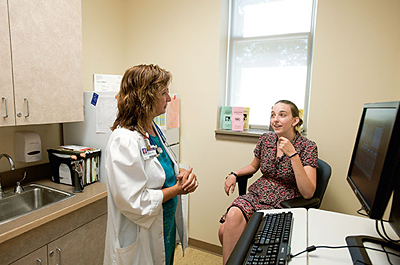

Student Health
Building toward Better Health
The University’s new student health building features improved convenience, counseling, and confidentiality.
By Kathleen McGarvey

CONVENIENT SERVICE: Patricia Morse ’10 (right) talks with Mary Madsen of University Health Service; the new building is located near Susan B. Anthony Hall and Rush Rhees Library.
There’s a new occupant of the hill by the Susan B. Anthony Residence Hall, where “the Rock” formerly stood. It’s the freshly constructed University Health Service Building, and from its central location to its carefully planned interior, it promises significant changes in health care for River Campus students.
The new facility “is so accessible for students, especially first-year students in Susan B. Anthony Hall,” says Nancy Reynolds, a health educator with University Health Service (UHS).
Formerly, UHS had offices scattered around the University campus, with clinical offices, administrative offices, and counseling services in different locations. The main clinical office was in the Medical Center—not the most convenient place for students on the River Campus.
“When you’re sick and it’s the middle of winter, the Medical Center can seem a long way,” says Linda Dudman, associate director of the Health Promotion Office at UHS.
While the Medical Center office and another clinical office at the Eastman School will remain open, the UHS building will become the primary health-care stop for Arts, Sciences & Engineering students. UHS also treats Rochester faculty and staff, as well as other members of the University community.
Finding the right spot on campus took two to three years, says Ann McMican, associate director for administration of UHS. “Trying to be good stewards, we looked at retrofitting” other facilities, “but the cost was always much higher,” she says.
The location they finally found is ideal, McMican adds, with its proximity to residence halls and the sports fields, and its fit with the campus around it. “We didn’t want to take green space that could be used for other things,” she says.
The University carried out a geological analysis of the hill for evidence of geological or anthropological significance, and concluded that the raised terrain was the result of earlier construction nearby.
The building is a decidedly “green” one, employing recycled materials, natural light, low-flow water options, and energy-saving heating and cooling systems.
“One of the things we took into consideration is that nature is important to health,” McMican explains. The University planted more new trees than were lost to construction, and the building also boasts a garden highlighting local and medicinal plants such as willows (the original source of aspirin), witch hazel, and gingko trees.
“And a bank of apple trees,” she adds, “because the apple is our symbol of good health.”
The building’s most important features, however, focus on patient care. Consolidating medical services will provide better teamwork between caregivers, allowing for higher quality and more accessible treatment.
Designed to be of service in the event of a campus emergency, the building contains a negative pressure room for respiratory isolation and a classroom with 18 phone lines in the floor to establish an emergency phone bank on campus, should one be necessary—a capacity that also did not exist before.
The new facility also offers improved confidentiality. When doors are closed, a special seal locks into place for auditory privacy, and—unusually for contemporary construction—walls rise above ceilings to meet the deck of the next floor, also to prevent sound from traveling.
Counseling services are also now housed in the UHS building, instead of in counseling-only locations away from the main campus, as they were formerly.
“This will help students have the motivation to go and seek counseling,” says Stefanie Trop ’08, of Riverside, Conn., who is a member of the Student Health Advisory Committee and a music and microbiology major now working on a Take 5 project in Jewish studies.
“And even though this is in the middle of campus, it’s more private,” she adds.
“There’s a certain anonymity for students coming into the building,” Dudman says. “There’s so many reasons why someone might be coming in the front doors,” from health and society classes to counseling services or an appointment with a physician.
“I’m really excited,” says Trop, who was employed over the summer with UHS, “and everyone who works here is thrilled.”
